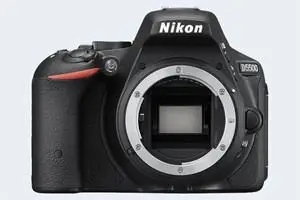Nikon D5500 vs Sony RX0 II
The Nikon D5500 and the Sony Cyber-shot DSC-RX0II are two digital cameras that were revealed to the public, respectively, in January 2015 and March 2019. The D5500 is a DSLR, while the RX0 II is a fixed lens compact. The cameras are based on an APS-C (D5500) and an one-inch (RX0 II) sensor. The Nikon has a resolution of 24 megapixels, whereas the Sony provides 15.4 MP.
Below is an overview of the main specs of the two cameras as a starting point for the comparison.

Check D5500 offers at
ebay.com

Check RX0 II price at
amazon.com
Going beyond this snapshot of core features and characteristics, what are the differences between the Nikon D5500 and the Sony Cyber-shot DSC-RX0II? Which one should you buy? Read on to find out how these two cameras compare with respect to their body size, their imaging sensors, their shooting features, their input-output connections, and their reception by expert reviewers.
Body comparison
An illustration of the physical size and weight of the Nikon D5500 and the Sony RX0 II is provided in the side-by-side display below. The two cameras are presented according to their relative size. Three consecutive views from the front, the top, and the rear side are shown. All width, height and depth measures are rounded to the nearest millimeter.
The D5500 can be obtained in two different colors (black, red), while the RX0 II is only available in black.
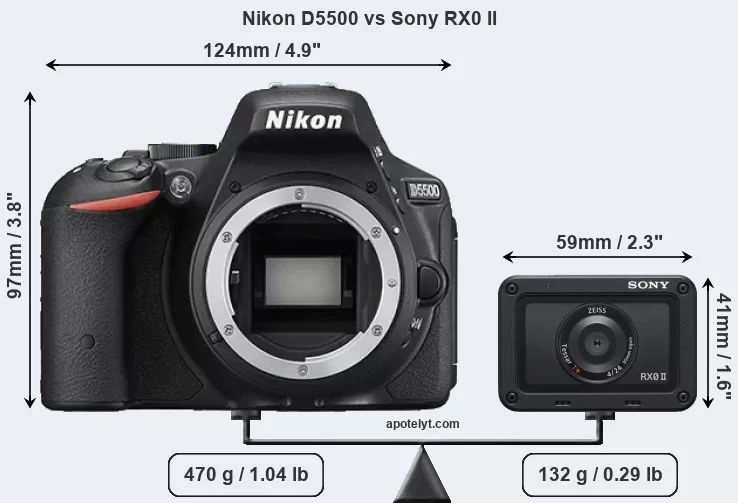
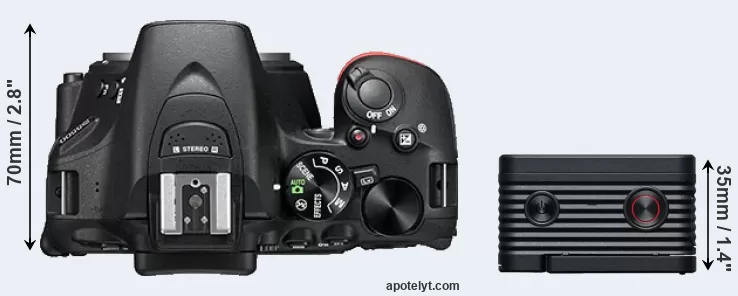
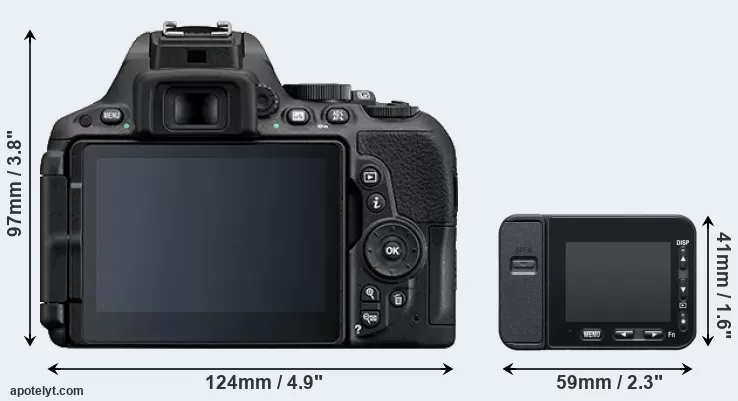
If the front view area (width x height) of the cameras is taken as an aggregate measure of their size, the Sony RX0 II is considerably smaller (80 percent) than the Nikon D5500. It is noteworthy in this context that the RX0 II is splash and dust-proof, while the D5500 does not feature any corresponding weather-sealing. More than that, the RX0 II is water-proof up to 10m and can, thus, be used for underwater photography.
The above size and weight comparisons are to some extent incomplete and possibly misleading, as the RX0 II has a lens built in, whereas the D5500 is an interchangeable lens camera that requires a separate lens. Attaching the latter will add extra weight and bulk to the setup. You can compare the optics available for the D5500 and their specifications in the Nikon Lens Catalog.
Concerning battery life, the D5500 gets 820 shots out of its Nikon EN-EL14a battery, while the RX0 II can take 240 images on a single charge of its Sony NP-BJ1 power pack. The power pack in the RX0 II can be charged via the USB port, which can be very convenient when travelling.
The table below summarizes the key physical specs of the two cameras alongside a broader set of comparators. If you would like to visualize and compare a different camera combination, you can navigate to the CAM-parator app and make your selection from a broad list of cameras there.

| Camera Model |
Camera Width |
Camera Height |
Camera Depth |
Camera Weight |
Battery Life |
Weather Sealing |
Camera Launch |
Launch Price (USD) |
Street Price |
||
|---|---|---|---|---|---|---|---|---|---|---|---|
| 1. | Nikon D5500 | 124 mm | 97 mm | 70 mm | 470 g | 820 | n | Jan 2015 | 899 | ebay.com | |
| 2. | Sony RX0 II | 59 mm | 41 mm | 35 mm | 132 g | 240 | Y | Mar 2019 | 699 | amazon.com | |
| 3. | Canon M5 | 116 mm | 89 mm | 61 mm | 427 g | 295 | n | Sep 2016 | 979 | ebay.com | |
| 4. | Nikon D500 | 147 mm | 115 mm | 81 mm | 860 g | 1240 | Y | Jan 2016 | 1,999 | ebay.com | |
| 5. | Nikon D3200 | 125 mm | 96 mm | 77 mm | 505 g | 540 | n | Apr 2012 | 599 | ebay.com | |
| 6. | Nikon D3300 | 124 mm | 98 mm | 76 mm | 430 g | 700 | n | Jan 2014 | 499 | ebay.com | |
| 7. | Nikon D3400 | 124 mm | 98 mm | 76 mm | 445 g | 1200 | n | Aug 2016 | 499 | ebay.com | |
| 8. | Nikon D5100 | 128 mm | 97 mm | 79 mm | 560 g | 660 | n | Apr 2011 | 749 | ebay.com | |
| 9. | Nikon D5200 | 129 mm | 98 mm | 78 mm | 555 g | 500 | n | Nov 2012 | 749 | ebay.com | |
| 10. | Nikon D5300 | 125 mm | 98 mm | 76 mm | 480 g | 600 | n | Oct 2013 | 799 | ebay.com | |
| 11. | Nikon D5600 | 124 mm | 97 mm | 70 mm | 465 g | 970 | n | Nov 2016 | 699 | ebay.com | |
| 12. | Samsung NX30 | 127 mm | 96 mm | 58 mm | 375 g | 360 | n | Jan 2014 | 999 | ebay.com | |
| 13. | Sony RX0 | 59 mm | 41 mm | 30 mm | 110 g | 240 | Y | Aug 2017 | 699 | ebay.com | |
| 14. | Sony RX10 II | 129 mm | 88 mm | 102 mm | 813 g | 400 | Y | Jun 2015 | 1,299 | ebay.com | |
| 15. | Sony RX10 III | 133 mm | 94 mm | 127 mm | 1051 g | 420 | Y | Mar 2016 | 1,499 | ebay.com | |
| 16. | Sony RX10 IV | 133 mm | 94 mm | 145 mm | 1095 g | 400 | Y | Sep 2017 | 1,699 | amazon.com | |
| 17. | Sony ZV-1 | 105 mm | 60 mm | 44 mm | 294 g | 260 | n | May 2020 | 799 | ebay.com | |
| Note: Measurements and pricing do not include easily detachable parts, such as add-on or interchangeable lenses or optional viewfinders. | |||||||||||
Any camera decision will naturally be influenced heavily by the price. The listed launch prices provide an indication of the market segment that the manufacturer of the cameras have been targeting. The RX0 II was launched at a lower price than the D5500, despite having a lens built in. Normally, street prices remain initially close to the MSRP, but after a couple of months, the first discounts appear. Later in the product cycle and, in particular, when the replacement model is about to appear, further discounting and stock clearance sales often push the camera price considerably down. Then, after the new model is out, very good deals can frequently be found on the pre-owned market.
Sensor comparison
The size of the sensor inside a digital camera is one of the key determinants of image quality. A large sensor will tend to have larger individual pixels that provide better low-light sensitivity, wider dynamic range, and richer color-depth than smaller pixel-units in a sensor of the same technological generation. Moreover, a large sensor camera will give the photographer more control over depth-of-field in the image and, thus, the ability to better isolate a subject from the background. On the downside, larger sensors are more costly to manufacture and tend to lead to bigger and heavier cameras and lenses.
Of the two cameras under consideration, the Nikon D5500 features an APS-C sensor and the Sony RX0 II an one-inch sensor. The sensor area in the RX0 II is 68 percent smaller. As a result of these sensor size differences, the cameras have a format factor of, respectively, 1.5 and 2.7. Both cameras have a native aspect ratio (sensor width to sensor height) of 3:2.
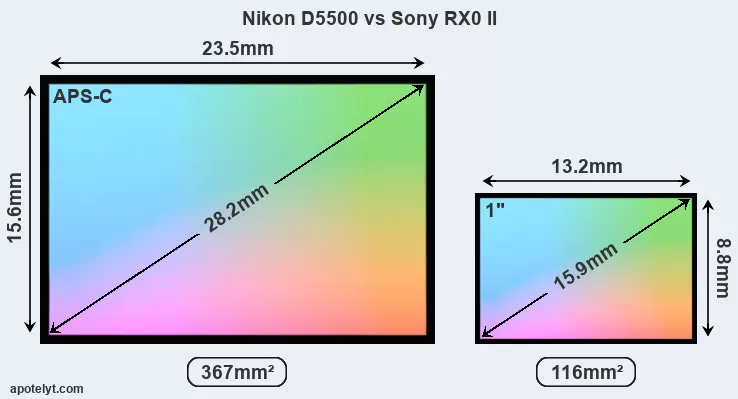
With 24MP, the D5500 offers a higher resolution than the RX0 II (15.4MP), but the D5500 nevertheless has larger individual pixels (pixel pitch of 3.91μm versus 2.74μm for the RX0 II) due to its larger sensor. However, the RX0 II is a much more recent model (by 4 years and 2 months) than the D5500, and its sensor will have benefitted from technological advances during this time that further enhance the light gathering capacity of its pixels. Coming back to sensor resolution, it should be mentioned that the D5500 has no anti-alias filter installed, so that it can capture all the detail its sensor resolves.
The resolution advantage of the Nikon D5500 implies greater flexibility for cropping images or the possibility to print larger pictures. The maximum print size of the D5500 for good quality output (200 dots per inch) amounts to 30 x 20 inches or 76.2 x 50.8 cm, for very good quality (250 dpi) 24 x 16 inches or 61 x 40.6 cm, and for excellent quality (300 dpi) 20 x 13.3 inches or 50.8 x 33.9 cm. The corresponding values for the Sony RX0 II are 24 x 16 inches or 61 x 40.6 cm for good quality, 19.2 x 12.8 inches or 48.8 x 32.5 cm for very good quality, and 16 x 10.7 inches or 40.6 x 27.1 cm for excellent quality prints.
The Nikon D5500 has a native sensitivity range from ISO 100 to ISO 25600. The corresponding ISO settings for the Sony Cyber-shot DSC-RX0II are ISO 80 to ISO 12800 (no boost).
Technology-wise, both cameras are equipped with CMOS (Complementary Metal–Oxide–Semiconductor) sensors. Both cameras use a Bayer filter for capturing RGB colors on a square grid of photosensors. This arrangement is found in most digital cameras.
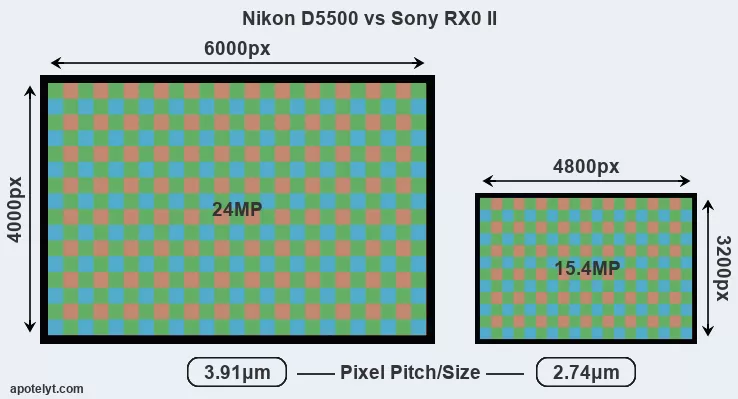
Since 2007, DXO Mark has published sensor performance measurements that have been derived using a consistent methodology. This service is based on lab testing and assigns an overall score to each camera sensor, as well as ratings for dynamic range ("DXO Landscape"), color depth ("DXO Portrait"), and low-light sensitivity ("DXO Sports"). The table below summarizes the physical sensor characteristics and sensor quality findings and compares them across a set of similar cameras.

| Camera Model |
Sensor Class |
Resolution (MP) |
Horiz. Pixels |
Vert. Pixels |
Video Format |
DXO Portrait |
DXO Landscape |
DXO Sports |
DXO Overall |
||
|---|---|---|---|---|---|---|---|---|---|---|---|
| 1. | Nikon D5500 | APS-C | 24.0 | 6000 | 4000 | 1080/60p | 24.1 | 14.0 | 1438 | 84 | |
| 2. | Sony RX0 II | 1-inch | 15.4 | 4800 | 3200 | 4K/30p | 22.1 | 12.4 | 555 | 65 | |
| 3. | Canon M5 | APS-C | 24.0 | 6000 | 4000 | 1080/60p | 23.4 | 12.4 | 1262 | 77 | |
| 4. | Nikon D500 | APS-C | 20.7 | 5568 | 3712 | 4K/30p | 24.0 | 14.0 | 1324 | 83 | |
| 5. | Nikon D3200 | APS-C | 24.1 | 6016 | 4000 | 1080/30p | 24.1 | 13.2 | 1131 | 81 | |
| 6. | Nikon D3300 | APS-C | 24.0 | 6000 | 4000 | 1080/60p | 24.3 | 12.8 | 1385 | 82 | |
| 7. | Nikon D3400 | APS-C | 24.0 | 6000 | 4000 | 1080/60p | 24.8 | 13.9 | 1192 | 86 | |
| 8. | Nikon D5100 | APS-C | 16.1 | 4928 | 3264 | 1080/30p | 23.5 | 13.6 | 1183 | 80 | |
| 9. | Nikon D5200 | APS-C | 24.0 | 6000 | 4000 | 1080/60i | 24.2 | 13.9 | 1284 | 84 | |
| 10. | Nikon D5300 | APS-C | 24.0 | 6000 | 4000 | 1080/60p | 24.0 | 13.9 | 1338 | 83 | |
| 11. | Nikon D5600 | APS-C | 24.0 | 6000 | 4000 | 1080/60p | 24.1 | 14.0 | 1306 | 84 | |
| 12. | Samsung NX30 | APS-C | 20.0 | 5472 | 3648 | 1080/60p | 23.5 | 12.4 | 1014 | 76 | |
| 13. | Sony RX0 | 1-inch | 15.4 | 4800 | 3200 | 1080/60p | 22.4 | 12.4 | 548 | 68 | |
| 14. | Sony RX10 II | 1-inch | 20.0 | 5472 | 3648 | 4K/30p | 23.0 | 12.6 | 531 | 70 | |
| 15. | Sony RX10 III | 1-inch | 20.0 | 5472 | 3648 | 4K/30p | 23.1 | 12.6 | 472 | 70 | |
| 16. | Sony RX10 IV | 1-inch | 20.0 | 5472 | 3648 | 4K/30p | 22.0 | 12.2 | 408 | 63 | |
| 17. | Sony ZV-1 | 1-inch | 20.0 | 5472 | 3648 | 4K/30p | 22.2 | 12.6 | 669 | 66 | |
| Note: DXO values in italics represent estimates based on sensor size and age. | |||||||||||
Many modern cameras are not only capable of taking still images, but can also record movies. Both cameras under consideration have a sensor with sufficiently fast read-out times for moving pictures, but the RX0 II provides a better video resolution than the D5500. It can shoot movie footage at 4K/30p, while the Nikon is limited to 1080/60p.
Feature comparison
Beyond body and sensor, cameras can and do differ across a range of features. For example, the D5500 has an optical viewfinder, which can be very useful when shooting in bright sunlight. In contrast, the RX0 II relies on live view and the rear LCD for framing. The following table reports on some other key feature differences and similarities of the Nikon D5500, the Sony RX0 II, and comparable cameras.

| Camera Model |
Viewfinder (Type or 000 dots) |
Control Panel (yes/no) |
LCD Specifications (inch/000 dots) |
LCD Attach- ment |
Touch Screen (yes/no) |
Max Shutter Speed * |
Max Shutter Flaps * |
Built-in Flash (yes/no) |
Built-in Image Stab |
||
|---|---|---|---|---|---|---|---|---|---|---|---|
| 1. | Nikon D5500 | optical | n | 3.2 / 1037 | swivel | Y | 1/4000s | 5.0/s | Y | n | |
| 2. | Sony RX0 II | none | n | 1.5 / 230 | tilting | n | .. | 5.5/s | n | n | |
| 3. | Canon M5 | 2360 | n | 3.2 / 1620 | tilting | Y | 1/4000s | 9.0/s | Y | n | |
| 4. | Nikon D500 | optical | Y | 3.2 / 2359 | tilting | Y | 1/8000s | 10.0/s | n | n | |
| 5. | Nikon D3200 | optical | n | 3.0 / 921 | fixed | n | 1/4000s | 4.0/s | Y | n | |
| 6. | Nikon D3300 | optical | n | 3.0 / 921 | fixed | n | 1/4000s | 5.0/s | Y | n | |
| 7. | Nikon D3400 | optical | n | 3.0 / 921 | fixed | n | 1/4000s | 5.0/s | Y | n | |
| 8. | Nikon D5100 | optical | n | 3.0 / 921 | swivel | n | 1/4000s | 4.0/s | Y | n | |
| 9. | Nikon D5200 | optical | n | 3.0 / 921 | swivel | n | 1/4000s | 5.0/s | Y | n | |
| 10. | Nikon D5300 | optical | n | 3.2 / 1037 | swivel | n | 1/4000s | 5.0/s | Y | n | |
| 11. | Nikon D5600 | optical | n | 3.2 / 1037 | swivel | Y | 1/4000s | 5.0/s | Y | n | |
| 12. | Samsung NX30 | 2359 | n | 3.0 / 1036 | swivel | Y | 1/8000s | 9.0/s | Y | n | |
| 13. | Sony RX0 | none | n | 1.5 / 230 | fixed | n | .. | 5.5/s | n | n | |
| 14. | Sony RX10 II | 2359 | Y | 3.0 / 1229 | tilting | n | 1/3200s | 14.0/s | Y | Y | |
| 15. | Sony RX10 III | 2359 | Y | 3.0 / 1229 | tilting | n | 1/2000s | 14.0/s | Y | Y | |
| 16. | Sony RX10 IV | 2359 | Y | 3.0 / 1440 | tilting | Y | 1/2000s | 24.0/s | Y | Y | |
| 17. | Sony ZV-1 | none | n | 3.0 / 922 | swivel | Y | 1/2000s | 24.0/s | n | n | |
| Note: *) Information refers to the mechanical shutter, unless the camera only has an electronic one. | |||||||||||
One difference between the cameras concerns the presence of an on-board flash. The D5500 has one, while the RX0 II does not. While the built-in flash of the D5500 is not very powerful, it can at times be useful as a fill-in light.
Both cameras have an articulated rear screen that can be turned to be front-facing. This feature will be particularly appreciated by vloggers and photographers who are interested in taking selfies.The reported shutter speed information refers to the use of the mechanical shutter. Yet, some cameras only have an electronic shutter, while others have an electronic shutter in addition to a mechanical one. In fact, the RX0 II only has electronic shutter, which makes completely silent shooting possible. However, this mode is less suitable for photographing moving objects (risk of rolling shutter) or shooting under artificial light sources (risk of flickering).
The Nikon D5500 has an intervalometer built-in. This enables the photographer to capture time lapse sequences, such as flower blooming, a sunset or moon rise, without purchasing an external camera trigger and related software.
The D5500 writes its imaging data to SDXC cards, while the RX0 II uses micro SDXC or Memory Stick Micro cards. Both cameras can use UHS-I cards, which provide for Ultra High Speed data transfer of up to 104 MB/s.
Connectivity comparison
For some imaging applications, the extent to which a camera can communicate with its environment can be an important aspect in the camera decision process. The table below provides an overview of the connectivity of the Nikon D5500 and Sony Cyber-shot DSC-RX0II and, in particular, the interfaces the cameras (and selected comparators) provide for accessory control and data transfer.

| Camera Model |
Hotshoe Port |
Internal Mic / Speaker |
Microphone Port |
Headphone Port |
HDMI Port |
USB Port |
WiFi Support |
NFC Support |
Bluetooth Support |
||
|---|---|---|---|---|---|---|---|---|---|---|---|
| 1. | Nikon D5500 | Y | stereo / mono | Y | - | mini | 2.0 | Y | - | - | |
| 2. | Sony RX0 II | - | stereo / mono | Y | - | micro | 2.0 | Y | - | Y | |
| 3. | Canon M5 | Y | stereo / mono | Y | - | mini | 2.0 | Y | Y | Y | |
| 4. | Nikon D500 | Y | stereo / mono | Y | Y | mini | 3.0 | Y | Y | Y | |
| 5. | Nikon D3200 | Y | mono / mono | Y | - | mini | 2.0 | - | - | - | |
| 6. | Nikon D3300 | Y | mono / mono | Y | - | mini | 2.0 | - | - | - | |
| 7. | Nikon D3400 | Y | mono / mono | - | - | mini | 2.0 | - | - | Y | |
| 8. | Nikon D5100 | Y | mono / mono | Y | - | mini | 2.0 | - | - | - | |
| 9. | Nikon D5200 | Y | stereo / mono | Y | - | mini | 2.0 | - | - | - | |
| 10. | Nikon D5300 | Y | stereo / mono | Y | - | mini | 2.0 | Y | - | - | |
| 11. | Nikon D5600 | Y | stereo / mono | Y | - | mini | 2.0 | Y | Y | Y | |
| 12. | Samsung NX30 | Y | stereo / mono | - | - | micro | 2.0 | Y | Y | - | |
| 13. | Sony RX0 | - | stereo / mono | Y | - | micro | 2.0 | Y | - | Y | |
| 14. | Sony RX10 II | Y | stereo / mono | Y | Y | micro | 2.0 | Y | Y | - | |
| 15. | Sony RX10 III | Y | stereo / mono | Y | Y | micro | 2.0 | Y | Y | - | |
| 16. | Sony RX10 IV | Y | stereo / mono | Y | Y | micro | 2.0 | Y | Y | - | |
| 17. | Sony ZV-1 | Y | stereo / mono | Y | - | micro | 2.0 | Y | - | Y |
It is notable that the D5500 has a hotshoe, while the RX0 II does not. This socket makes it possible to easily attach optional accessories, such as an external flash gun.
The RX0 II is a recent model that features in the current product line-up of Sony. In contrast, the D5500 has been discontinued (but can be found pre-owned on ebay). As a replacement in the same line of cameras, the D5500 was succeeded by the Nikon D5600. Further information on the features and operation of the D5500 and RX0 II can be found, respectively, in the Nikon D5500 Manual (free pdf) or the online Sony RX0 II Manual.
Review summary
So how do things add up? Which of the two cameras – the Nikon D5500 or the Sony RX0 II – has the upper hand? Is one clearly better than the other? A synthesis of the relative strong points of each of the models is listed below.

Arguments in favor of the Nikon D5500:
- More detail: Offers more megapixels (24 vs 15.4MP) with a 25% higher linear resolution.
- Maximized detail: Lacks an anti-alias filter to exploit the sensor's full resolution potential.
- Easier framing: Has an optical viewfinder for image composition and settings control.
- Larger screen: Has a bigger rear LCD (3.2" vs 1.5") for image review and settings control.
- More detailed LCD: Has a higher resolution rear screen (1037k vs 230k dots).
- More flexible LCD: Has a swivel screen for odd-angle shots in portrait or landscape orientation.
- Fewer buttons to press: Is equipped with a touch-sensitive rear screen to facilitate handling.
- Easier time-lapse photography: Has an intervalometer built-in for low frequency shooting.
- More flexible: Can take a variety of interchangeable lenses, including specialty optics.
- Longer lasting: Can take more shots (820 versus 240) on a single battery charge.
- Easier fill-in: Is equipped with a small onboard flash to brighten deep shadow areas.
- Better lighting: Features a hotshoe and can thus hold and trigger an external flash gun.
- More heavily discounted: Has been available for much longer (launched in January 2015).

Reasons to prefer the Sony Cyber-shot DSC-RX0II:
- Better moiré control: Has an anti-alias filter to avoid artificial patterns to appear in images.
- Better video: Provides higher definition movie capture (4K/30p vs 1080/60p).
- Less disturbing: Has an electronic shutter option for completely silent shooting.
- Ready to shoot: Comes with an integrated lens, while the D5500 requires a separate lens.
- More compact: Is smaller (59x41mm vs 124x97mm) and will fit more readily into a bag.
- Less heavy: Has a lower weight even though it has a lens built in (unlike the D5500).
- Easier travel charging: Can be conveniently charged via its USB port.
- Better sealing: Is splash and dust sealed for shooting in inclement weather conditions.
- Water-proof: Is rugged and sealed and can thus be used for underwater photography (up to 10m).
- Easier wireless transfer: Supports Bluetooth for image sharing without cables.
- More affordable: Was introduced at a lower price, despite coming with a built-in lens.
- More modern: Reflects 4 years and 2 months of technical progress since the D5500 launch.
If the count of individual advantages (bullet points above) is taken as a guide, the D5500 comes out slightly ahead of the RX0 II (13 : 12 points). However, the relevance of individual strengths will vary across photographers, so that you might want to apply your own weighing scheme to the summary points when reflecting and deciding on a new camera. A professional wedding photographer will view the differences between cameras in a way that diverges from the perspective of a travel photog, and a person interested in cityscapes has distinct needs from a macro shooter. Hence, the decision which camera is best and worth buying is often a very personal one.
How about other alternatives? Do the specifications of the Nikon D5500 and the Sony RX0 II place the cameras among the top in their class? Find out in the latest Best DSLR Camera and Best Prime Lens Compact Camera listings whether the two cameras rank among the cream of the crop.
In any case, while the specs-based evaluation of cameras can be instructive in revealing their potential as photographic tools, it remains partial and cannot reveal, for example, the shooting experience and imaging performance when actually working with the D5500 or the RX0 II. At times, user reviews, such as those published at amazon, address these issues in a useful manner, but such feedback is on many occasions incomplete, inconsistent, and unreliable.
Expert reviews
This is where reviews by experts come in. The adjacent summary-table relays the overall verdicts of several of the most popular camera review sites (amateurphotographer [AP], cameralabs [CL], digitalcameraworld [DCW], dpreview [DPR], ephotozine [EPZ], photographyblog [PB]). As can be seen, the professional reviewers agree in many cases on the quality of different cameras, but sometimes their assessments diverge, reinforcing the earlier point that a camera decision is often a very personal choice.

| Camera Model |
AP score |
CL score |
DCW score |
DPR score |
EPZ score |
PB score |
Camera Launch |
Launch Price (USD) |
Street Price |
||
|---|---|---|---|---|---|---|---|---|---|---|---|
| 1. | Nikon D5500 | 5/5 | + | .. | 79/100 | 4.5/5 | 4.5/5 | Jan 2015 | 899 | ebay.com | |
| 2. | Sony RX0 II | .. | .. | .. | .. | 3.5/5 | 4/5 | Mar 2019 | 699 | amazon.com | |
| 3. | Canon M5 | 4/5 | + | 4/5 | 82/100 | 4/5 | 4/5 | Sep 2016 | 979 | ebay.com | |
| 4. | Nikon D500 | 5/5 | + + | 4.7/5 | 91/100 | 4.5/5 | 5/5 | Jan 2016 | 1,999 | ebay.com | |
| 5. | Nikon D3200 | 5/5 | + + | .. | 73/100 | 4.5/5 | 4.5/5 | Apr 2012 | 599 | ebay.com | |
| 6. | Nikon D3300 | 3/5 | + | .. | 77/100 | 4.5/5 | 4.5/5 | Jan 2014 | 499 | ebay.com | |
| 7. | Nikon D3400 | 4/5 | + | 4/5 | 76/100 | 4/5 | 4.5/5 | Aug 2016 | 499 | ebay.com | |
| 8. | Nikon D5100 | 5/5 | + + | .. | 76/100 | 4.5/5 | 4.5/5 | Apr 2011 | 749 | ebay.com | |
| 9. | Nikon D5200 | 4/5 | + + | .. | 79/100 | 4.5/5 | 4.5/5 | Nov 2012 | 749 | ebay.com | |
| 10. | Nikon D5300 | 4/5 | + + | .. | 79/100 | 4.5/5 | 4.5/5 | Oct 2013 | 799 | ebay.com | |
| 11. | Nikon D5600 | 4/5 | .. | 4/5 | 79/100 | 4.5/5 | 4/5 | Nov 2016 | 699 | ebay.com | |
| 12. | Samsung NX30 | 3/5 | .. | .. | 77/100 | 4.5/5 | 4.5/5 | Jan 2014 | 999 | ebay.com | |
| 13. | Sony RX0 | .. | .. | .. | .. | 3.5/5 | 4/5 | Aug 2017 | 699 | ebay.com | |
| 14. | Sony RX10 II | 5/5 | + + | .. | 82/100 | 4.5/5 | 4/5 | Jun 2015 | 1,299 | ebay.com | |
| 15. | Sony RX10 III | 5/5 | + | .. | 84/100 | 4.5/5 | 4.5/5 | Mar 2016 | 1,499 | ebay.com | |
| 16. | Sony RX10 IV | 5/5 | + | 3.5/5 | 84/100 | 4.5/5 | 5/5 | Sep 2017 | 1,699 | amazon.com | |
| 17. | Sony ZV-1 | 4/5 | + | 4/5 | 85/100 | 4/5 | 4.5/5 | May 2020 | 799 | ebay.com | |
| Note: (+ +) highly recommended; (+) recommended; (o) reviewed; (..) not available. | |||||||||||
Care should be taken when interpreting the review scores above, though. The ratings were established in reference to similarly priced cameras that were available in the market at the time of the review. Thus, a score needs to be put into the context of the launch date and the launch price of the camera, and rating-comparisons among cameras that span long time periods or concern very differently equipped models make little sense. Also, please note that some of the review sites have changed their methodology and reporting over time.

Check D5500 offers at
ebay.com

Check RX0 II price at
amazon.com
Other camera comparisons
Did this review help to inform your camera decision process? In case you are interested in seeing how other cameras pair up, just make your choice using the following search menu. As an alternative, you can also directly jump to any one of the listed comparisons that were previously generated by the CAM-parator tool.
- Canon M vs Sony RX0 II
- Canon SX520 vs Sony RX0 II
- Fujifilm X-E4 vs Sony RX0 II
- Fujifilm X100F vs Sony RX0 II
- Leica C-LUX vs Nikon D5500
- Leica D-LUX 7 vs Nikon D5500
- Nikon D100 vs Sony RX0 II
- Nikon D5500 vs Nikon D7100
- Nikon D5500 vs Olympus PEN-F
- Nikon D5500 vs Panasonic TZ200
- Nikon D5500 vs Sony RX10 III
- Panasonic GX850 vs Sony RX0 II
Specifications: Nikon D5500 vs Sony RX0 II
Below is a side-by-side comparison of the specs of the two cameras to facilitate a quick review of their differences and common features.
| Camera Model | Nikon D5500 | Sony RX0 II |
|---|---|---|
| Camera Type | Digital single lens reflex | Fixed lens compact camera |
| Camera Lens | Nikon F mount lenses | 24mm f/4.0 |
| Launch Date | January 2015 | March 2019 |
| Launch Price | USD 899 | USD 699 |
| Sensor Specs | Nikon D5500 | Sony RX0 II |
| Sensor Technology | CMOS | CMOS |
| Sensor Format | APS-C Sensor | 1" Sensor |
| Sensor Size | 23.5 x 15.6 mm | 13.2 x 8.8 mm |
| Sensor Area | 366.6 mm2 | 116.16 mm2 |
| Sensor Diagonal | 28.2 mm | 15.9 mm |
| Crop Factor | 1.5x | 2.7x |
| Sensor Resolution | 24 Megapixels | 15.4 Megapixels |
| Image Resolution | 6000 x 4000 pixels | 4800 x 3200 pixels |
| Pixel Pitch | 3.91 μm | 2.74 μm |
| Pixel Density | 6.55 MP/cm2 | 13.22 MP/cm2 |
| Moiré control | no AA filter | Anti-Alias filter |
| Movie Capability | 1080/60p Video | 4K/30p Video |
| ISO Setting | 100 - 25,600 ISO | 80 - 12,800 ISO |
| Image Processor | EXPEED 4 | BIONZ X |
| DXO Sensor Quality (score) | 84 | .. |
| DXO Color Depth (bits) | 24.1 | .. |
| DXO Dynamic Range (EV) | 14.0 | .. |
| DXO Low Light (ISO) | 1438 | .. |
| Screen Specs | Nikon D5500 | Sony RX0 II |
| Viewfinder Type | Optical viewfinder | no viewfinder |
| Viewfinder Field of View | 95% | |
| Viewfinder Magnification | 0.57x | |
| LCD Framing | Live View | Live View |
| Rear LCD Size | 3.2inch | 1.5inch |
| LCD Resolution | 1037k dots | 230k dots |
| LCD Attachment | Swivel screen | Tilting screen |
| Touch Input | Touchscreen | no Touchscreen |
| Shooting Specs | Nikon D5500 | Sony RX0 II |
| Focus System | Phase-detect AF | Contrast-detect AF |
| Manual Focusing Aid | no Peaking Feature | Focus Peaking |
| Max Shutter Speed (mechanical) | 1/4000s | .. |
| Continuous Shooting | 5 shutter flaps/s | 5.5 shutter flaps/s |
| Electronic Shutter | no E-Shutter | up to 1/32000s |
| Time-Lapse Photography | Intervalometer built-in | no Intervalometer |
| Fill Flash | Built-in Flash | no On-Board Flash |
| Storage Medium | SDXC cards | mMS or mSDXC cards |
| Single or Dual Card Slots | Single card slot | Single card slot |
| UHS card support | UHS-I | UHS-I |
| Connectivity Specs | Nikon D5500 | Sony RX0 II |
| External Flash | Hotshoe | no Hotshoe |
| USB Connector | USB 2.0 | USB 2.0 |
| HDMI Port | mini HDMI | micro HDMI |
| Microphone Port | External MIC port | External MIC port |
| Wifi Support | Wifi built-in | Wifi built-in |
| Bluetooth Support | no Bluetooth | Bluetooth built-in |
| Body Specs | Nikon D5500 | Sony RX0 II |
| Environmental Sealing | not weather sealed | Waterproof body (10m) |
| Battery Type | Nikon EN-EL14a | Sony NP-BJ1 |
| Battery Life (CIPA) | 820 shots per charge | 240 shots per charge |
| In-Camera Charging | no USB charging | USB charging |
| Body Dimensions |
124 x 97 x 70 mm (4.9 x 3.8 x 2.8 in) |
59 x 41 x 35 mm (2.3 x 1.6 x 1.4 in) |
| Camera Weight | 470 g (16.6 oz) | 132 g (4.7 oz) |

Check D5500 offers at
ebay.com

Check RX0 II price at
amazon.com
Did you notice an error on this page? If so, please get in touch, so that we can correct the information.
